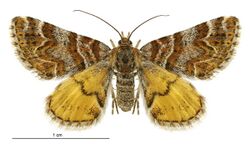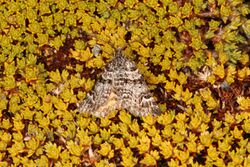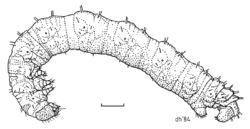Biology:Arctesthes catapyrrha
| Arctesthes catapyrrha | |
|---|---|

| |
| Male | |

| |
| Female | |
| Scientific classification | |
| Domain: | Eukaryota |
| Kingdom: | Animalia |
| Phylum: | Arthropoda |
| Class: | Insecta |
| Order: | Lepidoptera |
| Family: | Geometridae |
| Genus: | Arctesthes |
| Species: | A. catapyrrha
|
| Binomial name | |
| Arctesthes catapyrrha (Butler, 1877)[1]
| |
| Synonyms[1][2][3] | |
| |
Arctesthes catapyrrha is a moth of the family Geometridae.[2] It is endemic to New Zealand.
Taxonomy
This species was first described by Arthur Gardiner Butler in 1877 using specimens collected by James Hector and J. D. Enys and named Fidonia catapyrrha.[4] In 1884 Edward Meyrick placed this species in the newly described genus Stratonice.[5] In 1885 Meyrick replaced this preoccupied name with Arctesthes.[6] However also in 1885 Meyrick synonymised Arctesthes catapyrrha with Coremia euclidiata (now known as Chrysolarentia euclidiata).[7] In 1898 George Hudson discussed and illustrated this species under the name Lythria euclidiata, following this error made by Meyrick.[8] In 1912 George Blundell Longstaff corrected Meyrick's error.[9] In 1917 Meyrick agreed with that correction.[10] In 1928 Hudson again discussed and illustrated this species but this time, again following Meyrick, under the name Lythria catapyrrha.[11] Robin C. Craw in 1986 reinstated the genus Arctesthes and placed this species within it.[12] In 1988 J. S. Dugdale confirmed this placement and while doing so synonymised two forms, fasciata and kaikourensis, that had been previously named by Louis Beethoven Prout, into this species.[2] In 2019 Brian and Hamish Patrick as well as Robert Hoare reviewed the genus Arctesthes and again confirmed this species placement within it.[3] The male holotype specimen, collected at Castle Hill in Canterbury, is held at the Natural History Museum, London.[2]
Description
Butler described this species as follows:
♂,♀. Primaries above whitish, clouded and banded with brown ; the principal markings are an angulated transverse subbasal dark brown band ; two central bands forming a band, its inner edge subangulated, its outer edge very irregular, projecting within the median interspaces; an interrupted submarginal brown streak; a brown apical spot, and five oval marginal red spots enclosing black dots at their interior extremities ; fringe alternately brown and white ; secondaries ochre-yellow, with a central angulated bifid band, an angulated submarginal streak, and the outer border composed of dark grey scales ; a marginal series of black dots ; fringe grey ; body brown ; abdomen banded with white : primaries below stramineous ; an angulated postmedian band, bifid above the median nervure, a dot at end of cell, an irregular transverse tapering subapical streak, and the centre of the outer border black-brown ; a subapical spot, and the apical border pale ferruginous ; a spot on the costa, and an irregular apical submarginal streak, white ; fringe alternately brown and white ; secondaries brick-red ; a central longitudinal cuneiform streak proceeding from the base to near the outer margin, and the abdominal border, white ; a spot close to the base, a central angulated transverse band, a claviform submarginal streak, and a spot on the outer margin, black ; fringe grey ; body below whitish. Expanse of wings 8 1⁄2 lines.[4]
Dugdale mentions that the male holotype specimen collected in Canterbury has the typical colouration for that area of hindwings strongly coloured with red below.[2] Specimens in Otago have less red colouration and the discal strip is not red.[2]
Distribution
This species is endemic to New Zealand.[12][3] A. catapyrrha is widespread and is found in open areas from coastal to alpine locations.[13] It prefers stony habitat such as shingle riverbeds and stony fields.[14] It has been observed in the Mackenzie Country,[15] Kaitorete Spit,[16] near the Waimakariri River,[16] and in Central Otago.[17]
Life stages
A. catapyrrha is a day flying moth.[18] Adult moths can be seen between October and March.[16][18]
Host species
Larvae of A. catapyrrha feed on a wide range of low herbs including Plantago species and on Raoulia australis.[12][18] The adults of this moth are known to pollinate Raoulia subsericea.[19]
References
- ↑ 1.0 1.1 "NZOR Name Details - Arctesthes catapyrrha (Butler, 1877)". Landcare Research New Zealand Ltd.. http://www.nzor.org.nz/names/56ea3270-95a5-4f5b-8716-56bd00189c76.
- ↑ 2.0 2.1 2.2 2.3 2.4 2.5 Dugdale, J. S. (1988). "Lepidoptera - annotated catalogue, and keys to family-group taxa". Fauna of New Zealand 14: 170–171. ISSN 0111-5383. http://www.landcareresearch.co.nz/__data/assets/pdf_file/0003/49008/FNZ14Dugdale1988150.pdf. Retrieved 6 February 2017.
- ↑ 3.0 3.1 3.2 Patrick, Brian H.; Patrick, Hamish J.H.; Hoare, Robert J.B. (2019-05-29). "Review of the endemic New Zealand genus Arctesthes Meyrick (Lepidoptera, Geometridae, Larentiinae), with descriptions of two new range-restricted species". Alpine Entomology 3: 121–136. doi:10.3897/alpento.3.33944. ISSN 2535-0889. https://alpineentomology.pensoft.net/article/33944/.
- ↑ 4.0 4.1 Butler, Arthur Gardiner (1877). "On two collections of Heterocerous Lepidoptera from New Zealand, with descriptions of new genera and species." (in en). Proceedings of the Zoological Society of London: 379–407. https://www.biodiversitylibrary.org/page/28518294.
- ↑ , Wikidata Q109615359
- ↑ , Wikidata Q109608428
- ↑ , Wikidata Q111032066
- ↑ , Wikidata Q19073637
- ↑ , Wikidata Q108324136
- ↑ , Wikidata Q110727829
- ↑ , pp. 131, Wikidata Q58593286
- ↑ 12.0 12.1 12.2 Craw, R. C. (1986-01-01). "Review of the genus Notoreas (sensu auctorum) (Lepidoptera: Geometridae: Larentiinae)". New Zealand Journal of Zoology 13 (1): 131–140. doi:10.1080/03014223.1986.10422654. ISSN 0301-4223.
- ↑ Barratt, B. I. P.; Patrick, B. H. (1987). "Insects of snow tussock grassland on the East Otago Plateau.". New Zealand Entomologist 10 (1): 69–98. doi:10.1080/00779962.1987.9722513. https://www.researchgate.net/publication/233390130.
- ↑ Crowe, Andrew (2017) (in English). Which New Zealand insect?. Penguin Books. pp. 20. ISBN 978-0-14-100636-9. https://www.wikidata.org/wiki/Q105622564.
- ↑ Patrick, B. H. (1992). "Supplement to the Lepidoptera of the Mackenzie Country with recommendations on their conservation". New Zealand Entomologist 15 (1): 48–58. doi:10.1080/00779962.1992.9722629.
- ↑ 16.0 16.1 16.2 Patrick, Brian (1994). "Lepidoptera of Kaitorete Spit, Canterbury". New Zealand Entomologist 17 (1): 52–63. doi:10.1080/00779962.1994.9721985. ISSN 0077-9962.
- ↑ Allen, R. B.; McIntosh, P. D. (1995). "Guidelines for conservation of salt pans in Central Otago.". Science for Conservation 49: 1–46. http://www.doc.govt.nz/Documents/science-and-technical/sfc049.pdf.
- ↑ 18.0 18.1 18.2 Macfarlane R.P.; Patrick B.H.; Vink C.J. (1999). McLeans Island: invertebrate inventory and analysis. (Report). Christchurch City Council (Parks & Recreation Division) report.. pp. 1–44.
- ↑ , Wikidata Q54669862
External links
- Specimens held at the Auckland War Memorial Museum
- Image of specimen held at Te Papa Tongarewa Museum of New Zealand
Wikidata ☰ Q13392163 entry
 |



